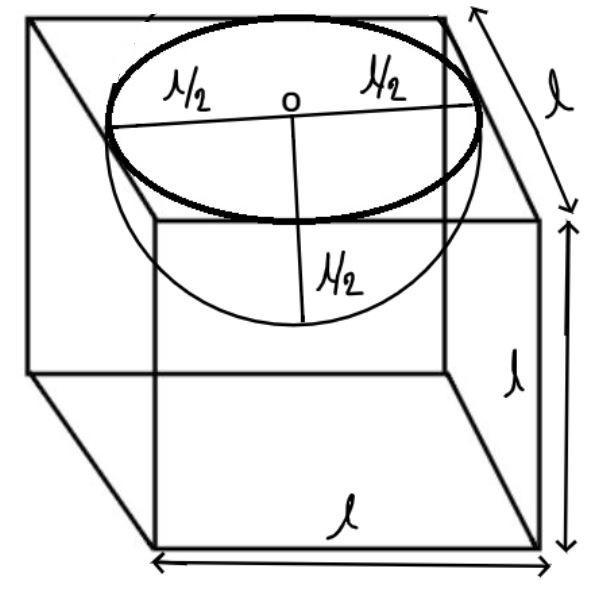
A hemispherical depression is cut out from one face of the cubical wooden block such that the diameter $l$ of the hemisphere is equal to the edge of the cube. Determine the surface area of the remaining solid.
Answer
514.2k+ views
Hint- Area of top of the hemispherical part\[ = \pi {r^2}\] sq. Unit, Curved surface area of the hemispherical part\[ = 2\pi {r^2}\] sq. unit

Consider the diagram shown above.
It is given that a hemisphere of diameter $l$unit is cut out from the top face of the cubical wooden block.
$\therefore $Radius of hemisphere\[\left( r \right) = \dfrac{{{\text{diameter}}}}{2} = \dfrac{l}{2}\]unit.
Therefore surface area of remaining solid
$ \Rightarrow $Surface area of the cuboidal box who’s each edge is of length $l$ unit$ - $Area of top of the hemispherical part$ + $Curved surface area of the hemispherical part.
$ \Rightarrow $Surface area of the cuboidal box who’s each edge is of length $l$ unit\[ = 6{l^2}\]sq. Unit
$ \Rightarrow $Area of top of the hemispherical part\[ = \pi {r^2}\] sq. Unit
$ \Rightarrow $Curved surface area of the hemispherical part\[ = 2\pi {r^2}\] sq. Unit
Therefore surface area$\left( A \right)$ of the remaining solid\[ = 6{l^2} - \pi {r^2} + 2\pi {r^2}\]
\[ = 6{l^2} - \pi {\left( {\dfrac{l}{2}} \right)^2} + 2\pi {\left( {\dfrac{l}{2}} \right)^2} = 6{l^2} - \pi \left( {\dfrac{{{l^2}}}{4}} \right) + \pi \left( {\dfrac{{{l^2}}}{2}} \right)\]
\[A = 6{l^2} + \pi \left( {\dfrac{{{l^2}}}{4}} \right) = \dfrac{{{l^2}}}{4}\left( {\pi + 24} \right)\] Sq. Unit
So, this is the required surface area of the remaining solid.
Note- In such types of questions after cutting the required portion according to the question then the remaining portion we found is not in a standard shape so we cannot determine surface area of the remaining solid directly, so we use the concept which is written above to determine the surface area of the remaining solid, then simplify we will get the required answer.

Consider the diagram shown above.
It is given that a hemisphere of diameter $l$unit is cut out from the top face of the cubical wooden block.
$\therefore $Radius of hemisphere\[\left( r \right) = \dfrac{{{\text{diameter}}}}{2} = \dfrac{l}{2}\]unit.
Therefore surface area of remaining solid
$ \Rightarrow $Surface area of the cuboidal box who’s each edge is of length $l$ unit$ - $Area of top of the hemispherical part$ + $Curved surface area of the hemispherical part.
$ \Rightarrow $Surface area of the cuboidal box who’s each edge is of length $l$ unit\[ = 6{l^2}\]sq. Unit
$ \Rightarrow $Area of top of the hemispherical part\[ = \pi {r^2}\] sq. Unit
$ \Rightarrow $Curved surface area of the hemispherical part\[ = 2\pi {r^2}\] sq. Unit
Therefore surface area$\left( A \right)$ of the remaining solid\[ = 6{l^2} - \pi {r^2} + 2\pi {r^2}\]
\[ = 6{l^2} - \pi {\left( {\dfrac{l}{2}} \right)^2} + 2\pi {\left( {\dfrac{l}{2}} \right)^2} = 6{l^2} - \pi \left( {\dfrac{{{l^2}}}{4}} \right) + \pi \left( {\dfrac{{{l^2}}}{2}} \right)\]
\[A = 6{l^2} + \pi \left( {\dfrac{{{l^2}}}{4}} \right) = \dfrac{{{l^2}}}{4}\left( {\pi + 24} \right)\] Sq. Unit
So, this is the required surface area of the remaining solid.
Note- In such types of questions after cutting the required portion according to the question then the remaining portion we found is not in a standard shape so we cannot determine surface area of the remaining solid directly, so we use the concept which is written above to determine the surface area of the remaining solid, then simplify we will get the required answer.
Recently Updated Pages
Master Class 11 Accountancy: Engaging Questions & Answers for Success

Express the following as a fraction and simplify a class 7 maths CBSE

The length and width of a rectangle are in ratio of class 7 maths CBSE

The ratio of the income to the expenditure of a family class 7 maths CBSE

How do you write 025 million in scientific notatio class 7 maths CBSE

How do you convert 295 meters per second to kilometers class 7 maths CBSE

Trending doubts
When people say No pun intended what does that mea class 8 english CBSE

In Indian rupees 1 trillion is equal to how many c class 8 maths CBSE

How many ounces are in 500 mL class 8 maths CBSE

Which king started the organization of the Kumbh fair class 8 social science CBSE

Advantages and disadvantages of science

What is BLO What is the full form of BLO class 8 social science CBSE




